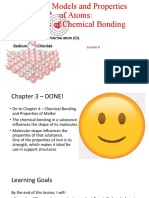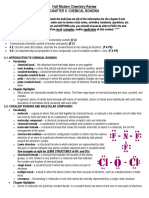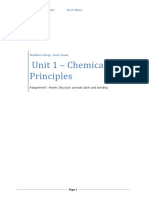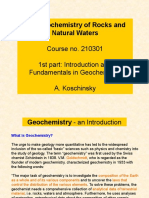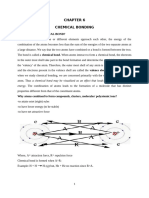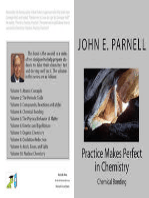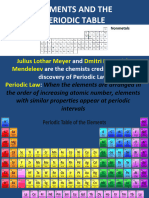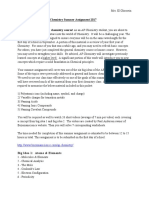0 ratings0% found this document useful (0 votes)
24 viewsUnit 3.2 - Covalent Bonding
Unit 3.2 - Covalent Bonding
Uploaded by
Aylin KasaThis document provides an overview of chemical bonding, specifically focusing on ionic bonding and covalent bonding. It discusses the key differences between ionic bonding, where electrons are transferred, and covalent bonding, where electrons are shared. It also describes non-polar covalent bonding, where shared electrons are pulled equally by identical non-metal atoms, and polar covalent bonding, where electrons are pulled differently by non-identical atoms. Examples are provided to illustrate polar and non-polar molecules. The document concludes with information on naming covalent compounds.
Copyright:
© All Rights Reserved
Available Formats
Download as PDF, TXT or read online from Scribd
Unit 3.2 - Covalent Bonding
Unit 3.2 - Covalent Bonding
Uploaded by
Aylin Kasa0 ratings0% found this document useful (0 votes)
24 views11 pagesThis document provides an overview of chemical bonding, specifically focusing on ionic bonding and covalent bonding. It discusses the key differences between ionic bonding, where electrons are transferred, and covalent bonding, where electrons are shared. It also describes non-polar covalent bonding, where shared electrons are pulled equally by identical non-metal atoms, and polar covalent bonding, where electrons are pulled differently by non-identical atoms. Examples are provided to illustrate polar and non-polar molecules. The document concludes with information on naming covalent compounds.
Original Title
UNIT 3.2- COVALENT BONDING
Copyright
© © All Rights Reserved
Available Formats
PDF, TXT or read online from Scribd
Share this document
Did you find this document useful?
Is this content inappropriate?
This document provides an overview of chemical bonding, specifically focusing on ionic bonding and covalent bonding. It discusses the key differences between ionic bonding, where electrons are transferred, and covalent bonding, where electrons are shared. It also describes non-polar covalent bonding, where shared electrons are pulled equally by identical non-metal atoms, and polar covalent bonding, where electrons are pulled differently by non-identical atoms. Examples are provided to illustrate polar and non-polar molecules. The document concludes with information on naming covalent compounds.
Copyright:
© All Rights Reserved
Available Formats
Download as PDF, TXT or read online from Scribd
Download as pdf or txt
0 ratings0% found this document useful (0 votes)
24 views11 pagesUnit 3.2 - Covalent Bonding
Unit 3.2 - Covalent Bonding
Uploaded by
Aylin KasaThis document provides an overview of chemical bonding, specifically focusing on ionic bonding and covalent bonding. It discusses the key differences between ionic bonding, where electrons are transferred, and covalent bonding, where electrons are shared. It also describes non-polar covalent bonding, where shared electrons are pulled equally by identical non-metal atoms, and polar covalent bonding, where electrons are pulled differently by non-identical atoms. Examples are provided to illustrate polar and non-polar molecules. The document concludes with information on naming covalent compounds.
Copyright:
© All Rights Reserved
Available Formats
Download as PDF, TXT or read online from Scribd
Download as pdf or txt
You are on page 1of 11
MYP CHEMISTRY
UNIT 3 : CHEMICAL BONDING
COVALENT BONDING
TITLE: BONDING
CONTENT : Chemical Species
ATL Skills:
Research : Information Literacy Skills
Thinking : Critical Thinking Skills , Transfer Skills
Key Concept: Relationships
Related Concept(s) : Pattern, interaction
Global Context : Identities and Relationships
Statement of Inquiry: To understand the
interactions between chemical species,
scientists observe bond types and their
physical and chemical changes
TITLE: BONDING
CONTENT : Chemical Species
Today’s Plan and Outcomes :
TITLE: CHEMICAL BONDING
CONTENT : Ionic Bonding
Let’s Remember :
We have seen ionic bonding first.
• Ionic bonding is one of the strongest bonding
which occurs between oppositely charged
ions.
• In an ionic bonding, metal gives its electron
or electrons to the non-metallic structure via
electron transfer.
Figures : MEB 9th Grade Book
TITLE: CHEMICAL BONDING
CONTENT : Ionic Bonding vs.
Covalent Bonding
Ionic Bonding vs. Covalent Bonding
or
• In covalent bonding electrons are SHARED
whereas in ionic bonding electron(s) is/are
transferred to the non metal.
• Ionic bonding : Metal + Non-metal
Covalent bonding : Non-metal + Non-metal
( Non-polar or polar covalent bond types)
• They are both called strong forces. They
want to complete their last shell into either
2 ( dublet) or 8 (octet).
Figures : MEB 9th Grade Book
TITLE: CHEMICAL BONDING
CONTENT : Non- Polar Covalent Bonding :
Shared electrons are pulled equally by
identical non- metal atoms Bond Structure :
TITLE: CHEMICAL BONDING
CONTENT : Polar Covalent Bonding : Shared
electrons are pulled differently by non-
identical non-metal atoms
TITLE: CHEMICAL BONDING
CONTENT : Determine! Are they polar or non-
polar covalently bonded molecules?
Since the lone pairs push the bonds in downward
direction, the molecule is POLAR. The specific shape for
water is called ‘bent’.
• Electronegativity is the
ability for pulling of
electrons towards itself in a
chemical compound.
• Since chlorine is more
electronegative ( check the
periodic table
property.Electronegativity
increases from left to the
right in the periodic table! )
this molecule is also polar.
Figures : MEB 9th Grade Book
TITLE: CHEMICAL BONDING
CONTENT : Determine! Are they polar or non-
polar covalently bonded molecules? Your
turn! How many bonds in total ?
All the elements are completing their
.....................................(octet/ dublet) in these
molecules.
Carbondioxide is ....................... (nonpolar / polar)
molecule.
Figures : MEB 9th Grade Book
TITLE: CHEMICAL BONDING
CONTENT: Naming of covalent bonded
compounds
• Number of the first nonmetal (in Latin), name of
the first nonmetal, number of the second
nonmetal (in Latin), ionic name of the second
nonmetal.
Figures Oran 9th Grade Course Book
TITLE: CHEMICAL BONDING
CONTENT: Naming of covalent bonded
compounds
Match Them !
Figures Oran 9th Grade Course Book
You might also like
- 50 Chapter09 LECDocument90 pages50 Chapter09 LEClelNo ratings yet
- Basic ChemistryDocument43 pagesBasic ChemistryKarim Wasi100% (8)
- Unit 3.1 - Lewis Structure and Ionic BondingDocument19 pagesUnit 3.1 - Lewis Structure and Ionic BondingAylin KasaNo ratings yet
- Bonding TheoriesDocument31 pagesBonding TheoriesMatthew HallNo ratings yet
- LECTURE 3-FunctionaL Groups and Water PropertiesDocument92 pagesLECTURE 3-FunctionaL Groups and Water Propertiesmwape260260No ratings yet
- Chemistry Chapter 6 ReviewDocument3 pagesChemistry Chapter 6 Reviewjuan carlos quispe mamaniNo ratings yet
- Chemistry Exam Notes Semester 2Document37 pagesChemistry Exam Notes Semester 2AnjaliNo ratings yet
- Chemical BondingDocument19 pagesChemical Bondingsajideu84No ratings yet
- Unit 2 (1) ChemistryDocument29 pagesUnit 2 (1) ChemistryHashley CastellyNo ratings yet
- Chapter 4Document17 pagesChapter 4rehmansher452No ratings yet
- PHSC - L3 Bond Polarity and Properties of CompoundsDocument31 pagesPHSC - L3 Bond Polarity and Properties of CompoundsRegene SoledadNo ratings yet
- Properties of Covalent BondingDocument9 pagesProperties of Covalent BondingMBOTAKE LawsonNo ratings yet
- General Bonding PowerpointDocument32 pagesGeneral Bonding PowerpointKennade BarberNo ratings yet
- Test 3 Bonding Review Sheet-Final VersionDocument7 pagesTest 3 Bonding Review Sheet-Final VersionJuventie PrimastutiNo ratings yet
- Electronegativity - MondayDocument17 pagesElectronegativity - MondayJela AlmonedaNo ratings yet
- Chapter 1 Bonding and Molecular Sructure I Chemical BondingDocument5 pagesChapter 1 Bonding and Molecular Sructure I Chemical BondingJonathan SaydeNo ratings yet
- 1.2 Chem Bonding and HybridizationDocument179 pages1.2 Chem Bonding and Hybridizationasimmughalmughalg365No ratings yet
- Lecture-3-Chemical Bonds and Functional GroupsDocument64 pagesLecture-3-Chemical Bonds and Functional GroupsWiza MulengaNo ratings yet
- Inorganic-Lec 4Document5 pagesInorganic-Lec 4s89844240No ratings yet
- Chemical Composition of The EarthDocument58 pagesChemical Composition of The EarthPutik Nurul ArasyNo ratings yet
- Chapter 4 - Chemical BondingDocument32 pagesChapter 4 - Chemical BondingFandyNo ratings yet
- Science 9 Week 3Document77 pagesScience 9 Week 3Eliseo MuyaNo ratings yet
- Chemical Bonding 1Document35 pagesChemical Bonding 1irma.javashviliNo ratings yet
- Chemical BondingDocument38 pagesChemical BondingK.B. DillipNo ratings yet
- Unit ViDocument33 pagesUnit ViIvy Marie ToyonganNo ratings yet
- Periodic Properties and The Periodic TableDocument6 pagesPeriodic Properties and The Periodic TableAurobinda MaharanaNo ratings yet
- Structure and Bonding - Ionic + Covalent BondsDocument9 pagesStructure and Bonding - Ionic + Covalent BondsKimaya RichardsNo ratings yet
- Group 2 Physical ScienceDocument10 pagesGroup 2 Physical ScienceJay Em Kristel MengulloNo ratings yet
- L.O.12chemistry G 10Document32 pagesL.O.12chemistry G 10bebo atefNo ratings yet
- Chem 101 Lec: Pt.1 Chemical BondingDocument36 pagesChem 101 Lec: Pt.1 Chemical BondingSarip RymahNo ratings yet
- L3-Molecular PolarityDocument20 pagesL3-Molecular PolarityMary Ann FriasNo ratings yet
- Lo5 1) Chemical BondsDocument9 pagesLo5 1) Chemical BondsabdogamreNo ratings yet
- 6 C15 Notes CH4 Chemical BondsSTEM StudentsDocument12 pages6 C15 Notes CH4 Chemical BondsSTEM StudentsDONNA JEAN ACOJEDONo ratings yet
- Assignment 1 Atomic StructureDocument9 pagesAssignment 1 Atomic StructureAnonymousNo ratings yet
- Chapter 2Document48 pagesChapter 2pxh4tncf9yNo ratings yet
- Chemical BondingDocument69 pagesChemical Bondingirenerielo19No ratings yet
- MELC 7 Chemical Bonding 1Document32 pagesMELC 7 Chemical Bonding 1A Dee YoungNo ratings yet
- 5.chemical BondingDocument40 pages5.chemical BondinggolandajxeroxNo ratings yet
- 1 ReviewDocument13 pages1 Reviewanon_821553381No ratings yet
- Organic Chemistry,: Structure & BondingDocument74 pagesOrganic Chemistry,: Structure & BondingilhamfaturachmanagusNo ratings yet
- Topic 4 BondingDocument13 pagesTopic 4 Bondinglobna masadehNo ratings yet
- VBT MotDocument23 pagesVBT Motskyanan592No ratings yet
- Lesson 4 - The Polarity of Molecule Based On Its StructureDocument48 pagesLesson 4 - The Polarity of Molecule Based On Its Structuretheresa balaticoNo ratings yet
- Basic Chemistry Course Lec-3 & 4Document21 pagesBasic Chemistry Course Lec-3 & 4Ariyan Abrar SaifNo ratings yet
- q1l3 - 2nd Sem Physical ScienceDocument12 pagesq1l3 - 2nd Sem Physical ScienceBilly Jasper DomingoNo ratings yet
- Carbon Compounds and Chemical Bonds Chm457Document83 pagesCarbon Compounds and Chemical Bonds Chm457kumukhriz100% (1)
- Lesson 1Document30 pagesLesson 1pulbopulNo ratings yet
- Chapter 3 Determining PolarityDocument39 pagesChapter 3 Determining Polarityjiptekaye.leberoNo ratings yet
- Geochemistry IntroductionDocument25 pagesGeochemistry Introductionkristiano97100% (1)
- Organic - Chemistry 1Document32 pagesOrganic - Chemistry 1ajyfsthNo ratings yet
- Lesson 3 Chemical PropertiesDocument32 pagesLesson 3 Chemical PropertiesJohann LeoncitoNo ratings yet
- Chemical BondingDocument81 pagesChemical BondingkhushiNo ratings yet
- Chapter 6Document34 pagesChapter 6gaimjohn2023No ratings yet
- A Molecular Approach Chapter 09Document120 pagesA Molecular Approach Chapter 09StephenNo ratings yet
- Chemical Composition of The EarthDocument58 pagesChemical Composition of The EarthPutik Nurul ArasyNo ratings yet
- Chemical Bonding, Structure and Shapes of Molecules and CompoundsDocument70 pagesChemical Bonding, Structure and Shapes of Molecules and Compoundsann wamburaNo ratings yet
- Structure of MoleculesDocument11 pagesStructure of MoleculesalxsxxdNo ratings yet
- Practice Makes Perfect in Chemistry: Chemical BondingFrom EverandPractice Makes Perfect in Chemistry: Chemical BondingRating: 5 out of 5 stars5/5 (3)
- Practice Makes Perfect in Chemistry: Chemical Bonding with AnswersFrom EverandPractice Makes Perfect in Chemistry: Chemical Bonding with AnswersRating: 5 out of 5 stars5/5 (1)
- Chemistry Chapter 10Document31 pagesChemistry Chapter 10Misbah JilaniNo ratings yet
- Chemical Effect and Electric CurrentDocument3 pagesChemical Effect and Electric CurrentRANJIT KUMAR SHAHNo ratings yet
- Naming Compounds ChemistryDocument58 pagesNaming Compounds ChemistryRizalyn Padua ReyNo ratings yet
- IA and IIA Group ElementsDocument4 pagesIA and IIA Group ElementsGagan NdNo ratings yet
- Flashcards - Topic 01 Atomic Structure and The Periodic Table - AQA Chemistry GCSEDocument137 pagesFlashcards - Topic 01 Atomic Structure and The Periodic Table - AQA Chemistry GCSEJaden HalkNo ratings yet
- ENS167 Chapter 3 Structures of Metals and CeramicsDocument101 pagesENS167 Chapter 3 Structures of Metals and CeramicsJerico MendañaNo ratings yet
- Cambridge O Level: Chemistry 5070/12Document16 pagesCambridge O Level: Chemistry 5070/12Islamabad ALMA SchoolNo ratings yet
- Transition Metal Chem Part 2-NomenclatureDocument3 pagesTransition Metal Chem Part 2-NomenclatureAakash VermaNo ratings yet
- IndustrialAndPreparativeResin CatalogueDocument26 pagesIndustrialAndPreparativeResin CatalogueI. Murali KrishnaNo ratings yet
- Primitive Model Electrolytes. I. Grand Canonical Monte Carlo ComputationsDocument8 pagesPrimitive Model Electrolytes. I. Grand Canonical Monte Carlo ComputationsHugo LivasNo ratings yet
- Class 12 Physics Chapter 1Document11 pagesClass 12 Physics Chapter 1Garry BroNo ratings yet
- Combined Science: Paper 5129/11 Multiple ChoiceDocument15 pagesCombined Science: Paper 5129/11 Multiple Choicemstudy123456No ratings yet
- Lecture 5: Bonding Models: Ionic BondsDocument4 pagesLecture 5: Bonding Models: Ionic BondsShreyas KamathNo ratings yet
- Electrolytic Processes (Book)Document7 pagesElectrolytic Processes (Book)JARVIS 31No ratings yet
- Cambridge IGCSE: Co-Ordinated Sciences 0654/42Document28 pagesCambridge IGCSE: Co-Ordinated Sciences 0654/42Shaurya MiglaniNo ratings yet
- Water (STPM)Document5 pagesWater (STPM)mei chyiNo ratings yet
- Sugar (Sucrose) (C12h22o11)Document12 pagesSugar (Sucrose) (C12h22o11)Karl SiaganNo ratings yet
- Kemix Activated Carbon in Gold RecoveryDocument49 pagesKemix Activated Carbon in Gold RecoveryErmys BermudezNo ratings yet
- ZBB Science Lab - Activities With-AnswersDocument50 pagesZBB Science Lab - Activities With-AnswersAl FernandezNo ratings yet
- Cot 2Document53 pagesCot 2Jhuneanne Mutia Caburnay-LirazanNo ratings yet
- Log Book Week 1 Week 2Document12 pagesLog Book Week 1 Week 2libbissujessyNo ratings yet
- Chap.1 ElectrochemistryDocument93 pagesChap.1 ElectrochemistryAnushkaSinhaNo ratings yet
- AP Chemistry Summer Assignment 2017Document44 pagesAP Chemistry Summer Assignment 2017John SmithNo ratings yet
- Fuels & Fairness Study Guide v1Document32 pagesFuels & Fairness Study Guide v1ChunkyLuverRudyNo ratings yet
- Transition MetalsDocument13 pagesTransition MetalsAaditya YadavNo ratings yet
- Bonding and StructuresDocument10 pagesBonding and StructuresFatema KhatunNo ratings yet
- Ion Exchange Chromatography PDFDocument170 pagesIon Exchange Chromatography PDFAmal Shalabi100% (1)
- Tutorial Questions Weeks 1-10 PDFDocument22 pagesTutorial Questions Weeks 1-10 PDFCharlotteNo ratings yet
- Simplified Focus Area Notes Ii CorrDocument8 pagesSimplified Focus Area Notes Ii Corrwargod RAMZNo ratings yet
- Trends in The Periodic TableDocument10 pagesTrends in The Periodic TableblossyNo ratings yet




